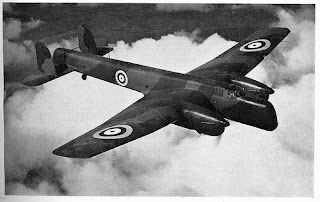The Armstrong Whitworth A.W.38 Whitley was one of three British twin-engine, front line medium bomber types in service with the Royal Air Force at the outbreak of the Second World War while the others were the Vickers Wellington and the Handley Page Hampden. It took part in the first RAF bombing raid on German territory, and remained an integral part of the early British bomber offensive until the introduction of four-engined "heavies". Its front line service included performing maritime reconnaissance duties with Coastal Command, while also being employed in the second line roles of glider-tug, trainer and transport aircraft.
Designed by John Lloyd, the Chief Designer of Armstrong Whitworth Aircraft to meet Air Ministry Specification issued in 1934 for a heavy night bomber. The AW.38 design was a development of the Armstrong Whitworth AW.23 bomber-transport design that had lost out to the Bristol Bombay for specification C.26/31 partly due to its Armstrong Siddeley Tiger engines.
As Lloyd was unfamiliar with the use of flaps on a large heavy monoplane, they were initially omitted. To compensate, the mid-set wings were set at a high angle of incidence (8.5°) to confer good takeoff and landing performance. Although flaps were included late in the design stage, the wing remained unaltered. As a result, the Whitley flew with a pronounced nose-down attitude, resulting in considerable drag. This "nose down" attitude was also seen in the design of the Armstrong Whitworth Ensign pre-war airliner.
The Mk.III introduced hydraulically actuated doors which greatly improved bombing accuracy. To aim bombs, the bombardier ("Bomb Aimer" in RAF terminology) opened a hatch in the nose of the aircraft which extended the bombsight out of the fuselage, but to everyone's comfort, the Mk IV replaced this hatch with a slightly extended transparency.
The Whitley first entered service with No. 10 Squadron in March 1937, replacing Handley Page Heyford biplanes, and by the outbreak of the Second World War, seven squadrons were operational with the Whitley. The majority were flying Whitley IIIs or IVs as the Whitley V had only just been introduced.
With Bomber Command, Whitleys flew 8,996 operations, dropped 9,845 tons of bombs with 269 aircraft lost in action. The Whitley was retired from all front line service in late 1942 but it continued to operate as a transport for troops and freight, as well as for paratroop training and towing gliders.
General characteristics
Performance
Armament
** Armstrong Whitworth - Warbird Fare
Designed by John Lloyd, the Chief Designer of Armstrong Whitworth Aircraft to meet Air Ministry Specification issued in 1934 for a heavy night bomber. The AW.38 design was a development of the Armstrong Whitworth AW.23 bomber-transport design that had lost out to the Bristol Bombay for specification C.26/31 partly due to its Armstrong Siddeley Tiger engines.
As Lloyd was unfamiliar with the use of flaps on a large heavy monoplane, they were initially omitted. To compensate, the mid-set wings were set at a high angle of incidence (8.5°) to confer good takeoff and landing performance. Although flaps were included late in the design stage, the wing remained unaltered. As a result, the Whitley flew with a pronounced nose-down attitude, resulting in considerable drag. This "nose down" attitude was also seen in the design of the Armstrong Whitworth Ensign pre-war airliner.
The Mk.III introduced hydraulically actuated doors which greatly improved bombing accuracy. To aim bombs, the bombardier ("Bomb Aimer" in RAF terminology) opened a hatch in the nose of the aircraft which extended the bombsight out of the fuselage, but to everyone's comfort, the Mk IV replaced this hatch with a slightly extended transparency.
The Whitley first entered service with No. 10 Squadron in March 1937, replacing Handley Page Heyford biplanes, and by the outbreak of the Second World War, seven squadrons were operational with the Whitley. The majority were flying Whitley IIIs or IVs as the Whitley V had only just been introduced.
With Bomber Command, Whitleys flew 8,996 operations, dropped 9,845 tons of bombs with 269 aircraft lost in action. The Whitley was retired from all front line service in late 1942 but it continued to operate as a transport for troops and freight, as well as for paratroop training and towing gliders.
General characteristics
- Crew: 5
- Length: 70 ft 6 in (21.49 m)
- Wingspan: 84 ft (25.60 m)
- Height: 15 ft (4.57 m)
- Wing area: 1,137 ft² (106 m²)
- Empty weight: 19,300 lb (8,768 kg)
- Max takeoff weight: 33,500 lb (15,196 kg)
- Powerplant: 2× Rolls-Royce Merlin X liquid-cooled V12 engine, 1,145 hp (855 kW) each
Performance
- Maximum speed: 200 kn (230 mph, 370 km/h) at 16,400 ft (5,000 m)
- Range: 1,430 nmi (1,650 mi, 2,650 km)
- Ferry range: 2,100 nmi (2,400 mi, 3,900 km)
- Service ceiling: 26,000 ft (7,900 m)
- Rate of climb: 800 ft/min (4.1 m/s)
- Max wing loading: 29.5 lb/ft² (143 kg/m²)
- Minimum power/mass: 0.684 hp/lb (112 W/kg)
Armament
- 1 × .303 in (7.7 mm) Vickers K machine gun in nose turret
- 4 × .303 in Browning machine guns in tail turret
- 12 × 250 lb (113 kg) bombs and
- 2 × 500 lb (227 kg) bombs or
- 1 × 2,000 lb (907 kg) bomb could be carried
** Armstrong Whitworth - Warbird Fare



 12/03/2010
12/03/2010
 Warbirdfare
Warbirdfare


 Tags :
Tags : 





